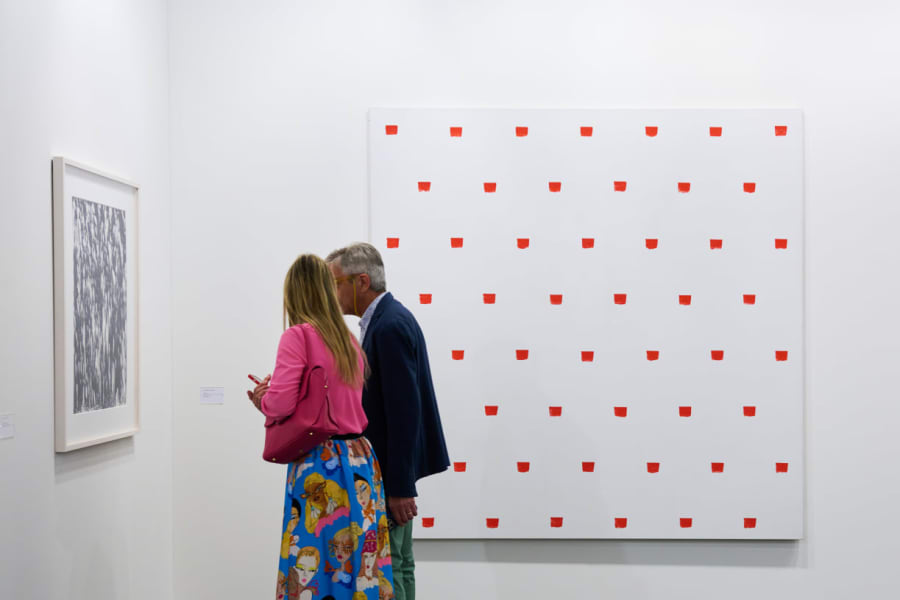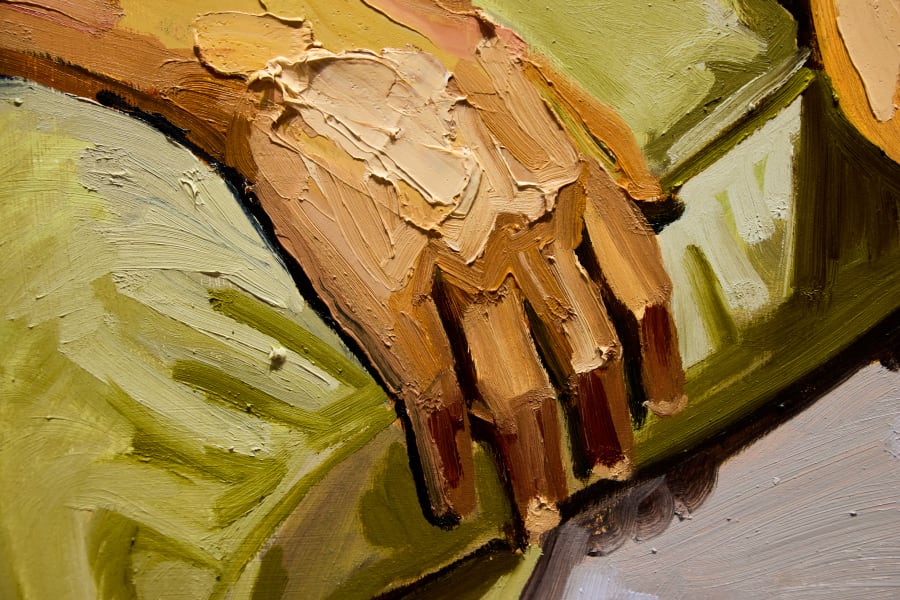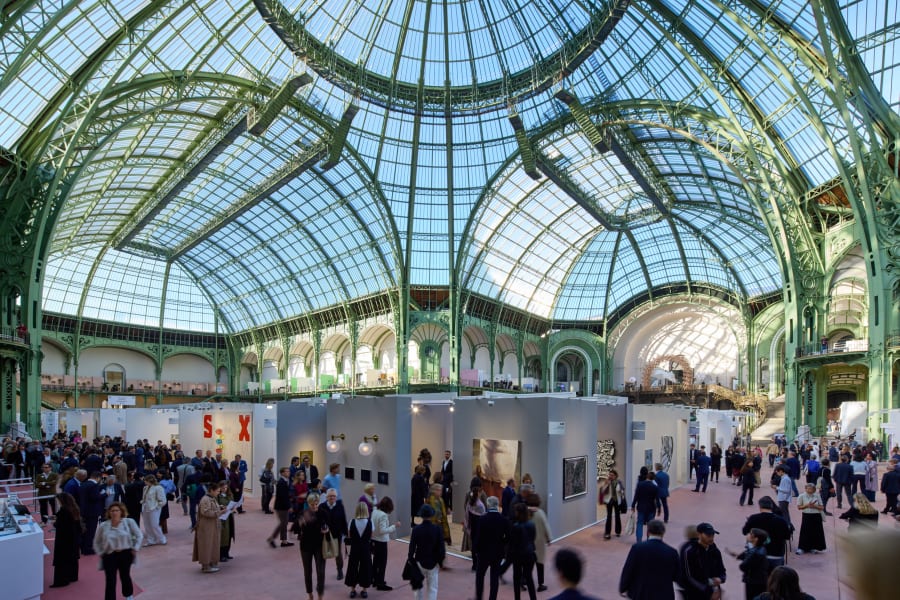駐紐約藝術家Jeremy Couillard原本是一名高中西班牙文教師,但在課堂之外,他投入大量時間創作複雜精細的漫畫和墨水畫。後來,他進入哥倫比亞大學攻讀藝術碩士,專心學習繪畫。但他很快感到厭倦:「我發現自己花在螢幕前的時間比在現實中的時間還多,因此科技話題越來越吸引我。甚至在畫畫時,我也大多是盯著電腦螢幕。」
因此,Couillard自學了程式設計,並開始嘗試動畫和3D遊戲創作工具虛幻引擎(Unreal Engine)。如今,他以創作敘事荒誕且帶有超現實主義風格的遊戲而聞名,比如《Escape from Lavender Island》(2023)。這款遊戲也在他目前於麻省理工學院李斯特視覺藝術中心(MIT List Visual Arts Center)舉辦的個展中佔據核心位置。觀眾可以坐在豆袋沙發上,化身遊戲主角Zede Aksis。這個綠色的雙足生物在監獄牢房中醒來,發現自己的反烏托邦城市夢境變成了現實。玩家的任務是逃離這個霓虹閃爍的恐怖都市。在逃亡中,他們追隨愛慕的物件,為舞蹈駐足,甚至可以戴上向路人噴射藥物的面具。Couillard談到這款帶有達達主義色彩的遊戲時說:「它關乎在城市中作為人類的生存體驗。遊戲很荒謬,但也的確非常悲涼。我想通過這款遊戲捕捉生存在當今社會的狀態。」
此次展覽還展示了一部隱隱透著詭秘氣息的視頻裝置,鏡頭掃過「Lavender Island」(薰衣草島)上奇異社區,伴隨著城市居民的旁白。不遠處,數碼繪製的木質花朵沿著地面綻放,牆上是幾幅色彩斑斕的畫作,猶如從遊戲中直接擷取的畫面。牆上還掛著一件滑稽的超大號螢光黃衛衣,上面印著「Depression」(抑鬱)。
展覽詼諧地批判了科技在社會中造成的疏離與隔閡。Couillard表示:「這種現象令人沮喪,但也讓人啼笑皆非,因為我們正在構建一個幾乎無人嚮往的科技世界,卻仍然義無反顧地向前推進。這個遊戲叫做《Escape from Lavender Island》(逃離薰衣草島),但在某種意義上,我們無法逃離現代生活。無論是福是禍,我們註定相伴。但我相信這終究是件好事,只要我們學會和彼此相處。」
Where supply has long been a concern for the very top end of the market, there is now a question as to a potential overabundance of single-sale collections in the future. Such headline collections have proven a lifeline to the major auction houses in recent years, notably the record-breaking USD 1.7 billion sale of Microsoft cofounder Paul Allen’s collection of works in 2022; so it is no surprise nerves are rattled. Among the highlights in New York this month is the Sotheby’s sale of the collection of beauty mogul Sydell Miller, estimated to be worth USD 200 million. The top lot is a water lily painting by Claude Monet, valued at around USD 60 million alone.
‘There is some anxiety over this new generation because there is fundamentally a huge question mark around shifting tastes. But it is also an excellent time for collectors who are fearless and confident in works that transcend time,’ Cromwell says.
Where wealth is being shifted, buying behaviors are assumed to be as prone to change as taste is. ‘New collectors are certainly using online platforms more frequently. Digital access to certain works of art levels the playing field and collectors can find works at a diverse range of price points, though the highest-end and most sought-after are still being offered very privately and with discretion to targeted collectors,’ says the New York-based adviser Megan Fox Kelly, who adds that there remains an exclusive segment of the market that is ‘very discreet’ A predisposition towards buying online, and a consideration of new ways of ownership, including fractionalization and securitization, look likely, while a heightened focus on the social and ethical content of art is also evident.
Others are recognizing consistency over change: ‘Despite the changes the wealth transfer may bring, key collector behaviors remain consistent,’ says Paul Donovan, the chief economist of UBS Global Wealth Management.
He adds: ‘The HNWIs surveyed in the Art Basel and UBS Survey of Global Collecting demonstrated a strong willingness to buy from new galleries in 2023 and 2024, with 88% of those purchasing from dealers buying from at least one new gallery. Respondents allocated 52% of their expenditure to works by new and emerging artists, with 21% on works by mid-career and 26% by established artists.’
Generational trends are only one piece of a complex puzzle shaped by broader social and economic factors, distinct developments across different geographies, and the fact that the art market itself is multifaceted. But while it may feel as if no one knows exactly what change is going to look like, everyone at least appears poised for its arrival.
Download the Art Basel and UBS Survey of Global Collecting 2024 here.
展覽「List Projects 30: Jeremy Couillard」由即日起至2024年10月6日於麻省理工學院李斯特視覺藝術中心展出。
本文作者Payal Uttam是一位常年於香港和新加坡兩地工作的獨立作家和編輯。她為不同出版物撰稿,包括Artsy、《藝術新聞》、《南華早報》及《華爾街日報》。
頁頂圖片標題:Jeremy Couillard,《Zede’s Dream》(靜幀),2023,圖片由藝術家提供
2024年9月2日發佈


